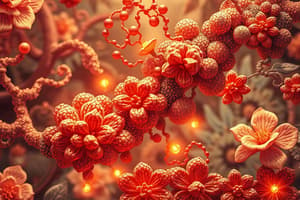Podcast
Questions and Answers
What are the major sources of folate?
What are the major sources of folate?
Folate is biochemically active in its polyglutamate form.
Folate is biochemically active in its polyglutamate form.
False (B)
What is the chemical name for folic acid?
What is the chemical name for folic acid?
Pteroylmonoglutamic acid
The major biological action of THF is ______ single carbon substituents.
The major biological action of THF is ______ single carbon substituents.
Signup and view all the answers
Match the following components with their corresponding parts of the folate molecule:
Match the following components with their corresponding parts of the folate molecule:
Signup and view all the answers
Which vitamin is essential for DNA synthesis and has a key role in cell division?
Which vitamin is essential for DNA synthesis and has a key role in cell division?
Signup and view all the answers
Vitamin B12 is primarily involved in the metabolism of carbohydrates.
Vitamin B12 is primarily involved in the metabolism of carbohydrates.
Signup and view all the answers
What is the main function of Folic Acid in the human body?
What is the main function of Folic Acid in the human body?
Signup and view all the answers
Folic Acid is also known as vitamin _____?
Folic Acid is also known as vitamin _____?
Signup and view all the answers
Match the following nutrients with their primary benefits:
Match the following nutrients with their primary benefits:
Signup and view all the answers
What is the primary biological importance of THF in metabolism?
What is the primary biological importance of THF in metabolism?
Signup and view all the answers
Folate deficiency can lead to normal levels of formiminoglutamic acid (FIGlu) in urine.
Folate deficiency can lead to normal levels of formiminoglutamic acid (FIGlu) in urine.
Signup and view all the answers
What is the main form of Vitamin B12 found in human plasma?
What is the main form of Vitamin B12 found in human plasma?
Signup and view all the answers
Vitamin B12 absorption requires a glycoprotein called __________.
Vitamin B12 absorption requires a glycoprotein called __________.
Signup and view all the answers
Match the following forms of Vitamin B12 with their primary characteristics:
Match the following forms of Vitamin B12 with their primary characteristics:
Signup and view all the answers
Which enzyme is critical for the synthesis of methionine from homocysteine?
Which enzyme is critical for the synthesis of methionine from homocysteine?
Signup and view all the answers
The liver is the major site of storage for Vitamin B12.
The liver is the major site of storage for Vitamin B12.
Signup and view all the answers
What is the minimal daily requirement of Vitamin B12 for adults?
What is the minimal daily requirement of Vitamin B12 for adults?
Signup and view all the answers
The conversion of __________ CoA to Succinyl CoA requires adenosylcobalamine.
The conversion of __________ CoA to Succinyl CoA requires adenosylcobalamine.
Signup and view all the answers
Match the following Vitamin B12 transport proteins with their functions:
Match the following Vitamin B12 transport proteins with their functions:
Signup and view all the answers
What condition is associated with increased levels of methylmalonate and propionate?
What condition is associated with increased levels of methylmalonate and propionate?
Signup and view all the answers
The majority of Vitamin B12 in circulation is bound to Transcobalamine II.
The majority of Vitamin B12 in circulation is bound to Transcobalamine II.
Signup and view all the answers
What is the primary metabolic role of methylene THF?
What is the primary metabolic role of methylene THF?
Signup and view all the answers
The active absorption of Vitamin B12 consists of about __________% of the total in food.
The active absorption of Vitamin B12 consists of about __________% of the total in food.
Signup and view all the answers
What is the consequence of a deficiency in Vitamin B12 regarding myelin?
What is the consequence of a deficiency in Vitamin B12 regarding myelin?
Signup and view all the answers
Study Notes
Folic Acid and Vitamin B12 Metabolism
- Folic acid, also known as pteroylmonoglutamic acid, is naturally found as polyglutamates.
- Its conversion to tetrahydrofolate (THF) is crucial for metabolic reactions.
- Folate is composed of a pteridine nucleus, para-aminobenzoic acid, and glutamic acid.
- Major sources of folate include green leafy vegetables, fruits, and liver.
- Folate is easily destroyed by heating.
- Folate absorption primarily occurs in the duodenum and proximal jejunum.
- Dietary folate (polyglutamates) is broken down to monoglutamates by intestinal conjugases.
- Monoglutamates are converted to 5-Methyl tetrahydrofolate (5-Methyl THF) in intestinal epithelial cells before entering portal circulation.
- Folate is released into the portal circulation as methyltetrahydrofolate (methyl THF).
- It is bound to an unknown protein in most cases and transported to various tissues.
- Folate is weakly bound to albumin.
- The liver is the primary storage site for folate as methyl THF polyglutamates.
- Normal daily dietary intake for adults is 100-150 µg.
- Body stores are 10-12 mg, sufficient for 4 months.
- Folate loss occurs via cells shed from skin and intestine, bile, urine, sweat, and saliva.
- The rate of folate loss is approximately 1-2% of total hepatic stores per day.
- The main function of THF is transferring single carbon units (methylene, methyl, formyl) to other compounds.
- Folate is essential for thymidylate synthesis, a crucial step in DNA synthesis.
- Folate deficiency leads to diminished deoxythymidine monophosphate (dTMP) synthesis.
- Folate is involved in the synthesis of methionine from homocysteine, purine synthesis, and histidine metabolism.
- Folate deficiency leads to impaired formiminoglutamic acid (FIGlu) metabolism, resulting in its increased excretion in the urine.
Vitamin B12 Introduction
- Vitamin B12 (cobalamin) consists of a corrin nucleus with four pyrrole rings (A-D) attached to a central cobalt atom.
- A 5,6-dimethylbenzimidazole is attached to the corrin ring and to the central cobalt atom.
- Important cobalamins, differentiated by the ligand attached to the central atom, include:
- Methylcobalamin (MethylB12): Predominant form in plasma.
- Deoxyadenosylcobalamin (adoB12): Key form in tissues.
- Hydroxocobalamin (hydroxoB12): Used in treatment.
- Cyanocobalamin (cyanoB12): Radioactively labeled form for studying absorption/metabolism (using 57Co or 58Co).
Vitamin B12 Sources
- Major sources include liver, meat, fish, and dairy products.
- Bacteria in the large intestine synthesize vitamin B12 but it's not absorbed.
Vitamin B12 Absorption
- Vitamin B12 absorption occurs through two mechanisms:
- Active transport, accounting for ~75% of B12 absorption, requiring intrinsic factor (IF). IF is a glycoprotein produced by parietal cells in the stomach lining.
- Passive diffusion, occurring when pharmacological doses of vitamin B12 are ingested. Only ~1% is absorbed via this method.
- In the stomach, pepsin releases vitamin B12 from proteins.
Vitamin B12 Transport
- Three plasma proteins bind vitamin B12:
- Transcobalamin I (TCI), now called Haptocorrin
- Transcobalamine II (TC II), now called TC II
- Transcobalamine III (TC III)
- TC II is the major vitamin B12 transport protein.
- It's synthesized by liver cells, macrophages, and hematopoietic cells.
- TC I acts primarily as a storage protein.
- Most circulating vitamin B12 is bound to TC I rather than TC II, with a minor portion bound to TC III.
Vitamin B12 Storage
- The liver is the main storage site.
- Normal daily dietary intake is 200-250 µg.
- Adults require 1-2 µg daily.
- Total body stores are 2-3 mg, sufficient for 2-4 years.
- Excretion occurs through bile and shedding of epithelial cells. Most excreted vitamin B12 is reabsorbed in the intestine (enterohepatic circulation).
Vitamin B12 Functions
- Vitamin B12 is essential for methionine synthesis from homocysteine, a reaction mediated by the enzyme methyltetrahydrofolate homocysteine methyltransferase, requiring methylcobalamin as a cofactor. Methyltetrahydrofolate is converted to tetrahydrofolate, necessary for methylene tetrahydrofolate formation.
- Methylene tetrahydrofolate is a cofactor for thymidylate synthesis, a crucial step in DNA synthesis.
- Vitamin B12 plays a role in the conversion of methylmalonyl CoA to succinyl CoA, a reaction requiring adenosylcobalamine and methylmalonyl CoA mutase.
- Increased methylmalonate and propionate levels are associated with vitamin B12 deficiency, leading to abnormal myelin synthesis and neurological abnormalities.
Role in DNA Synthesis
- Both Folate and Vitamin B12 are vital for DNA synthesis. They work together in a complex pathway.
Pathways Affected by Deficiencies
- Deficiencies in either folate or vitamin B12 disrupt various metabolic pathways, notably affecting DNA synthesis.
Studying That Suits You
Use AI to generate personalized quizzes and flashcards to suit your learning preferences.
Related Documents
Description
This quiz explores the essential roles of folic acid and vitamin B12 in metabolism, including their sources, absorption, and conversion processes. Learn the significance of these vitamins in maintaining health and how they affect bodily functions. Test your knowledge on these critical nutrients!




